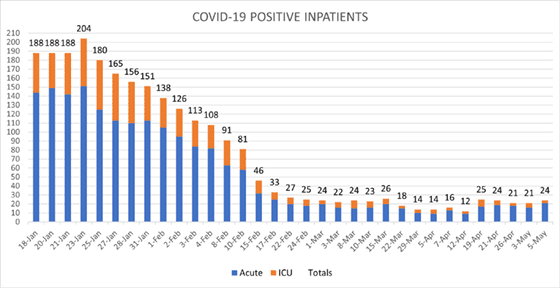QUICK READ:
- While the world around us is normalizing, we are also seeing an increase in COVID-19 cases locally and nationally and the emergence of a more transmissible subvariant in the United States.
- Given the current increase in cases, wearing masks in public indoor spaces (KN95 or N95 masks, ideally) continues to be recommended, especially if you’re traveling or anticipate being in crowded areas.
- Second boosters are recommended for people who are immunocompromised. Based on personal risk factors, other people who meet eligibility criteria may also be advised to get second boosters now.
- New variants and subvariants will likely force us to make modifications to our daily behavior and activity for the time being.
We are in the first week of May, and COVID-19 numbers in our broader community continue to climb slowly upward. We are also seeing that the BA.2 Omicron variant is being displaced by an even more transmissible BA.2.12 subvariant in the United States. At the same time, our world around us continues to normalize. I know this can be stressful for some of us and confusing for others – and maybe a little of both combined.
I hope that our UW Medicine policies and protocols to prioritize everyone’s health and safety will help alleviate some of your stress and/or confusion, at least while at work. Given the current increase in cases, I strongly recommend as a first step that you continue to wear masks in public indoor spaces (KN95 or N95 masks, ideally), especially if you’re traveling or anticipate being in crowded areas.
UW Medicine COVID-19 Activity Summary

Local/National/Global Epidemiology
King County: Public Health – Seattle & King County is reporting 400,181 total cases and 2,748 deaths as of Wednesday, May 4. The number of new positive tests over the last seven days is currently at 278.7 per 100,000 people.
Washington: The Department of Health reports 1,508,065 cases and 12,716 deaths as of May 3.
United States: The Centers for Disease Control and Prevention reports 73,720 new cases, 81,391,274 total COVID-19 cases and 993,341 deaths as of May 4.
Global: The WHO COVID-19 Dashboard reports 513,384,685 confirmed COVID-19 cases and 6,246,828 deaths as of May 5.
Second Boosters
Another common question is whether we should get second boosters if we meet eligibility criteria. In addition to recommending the boosters for people who are immunocompromised, my advice is that you should also consider getting a second booster if you live with someone who is immunocompromised or with children under 5 years of age. For additional advice, please check with your primary care provider.
Pandemic or Endemic?
A final question for today: What does the future of COVID-19 look like?
While we can’t say for sure, we seem to be entering into a phase of the pandemic in which variants and subvariants continue to emerge, forcing us to make new modifications to our daily behavior and activity. The one constant, however, is that your personal health risk and the risk within your household remain the key factors in being prepared for what’s to come. At some point in the future, we may look back and be able to say that this is when we started to transition into an endemic phase, but until then, we continue to live in the midst of an active pandemic.
In truth, we’re navigating in a new environment — a bit like exploring a new planet, with a new type of atmosphere, a new sense of gravity. As we continue to adapt and find our footing, there’s still a potentially lethal virus out there doing the same. Ultimately, we’ll make our way in this new world, smarter and stronger than we were. But until we do, we’ll have to continue being patient and vigilant while supporting each other during this time of transition. Thank you for your partnership in this effort.
Sincerely,
John Lynch, MD, MPH
Medical Director, Infection Prevention & Control
Associate Medical Director, Harborview Medical Center
Division of Allergy & Infectious Diseases, UW School of Medicine

